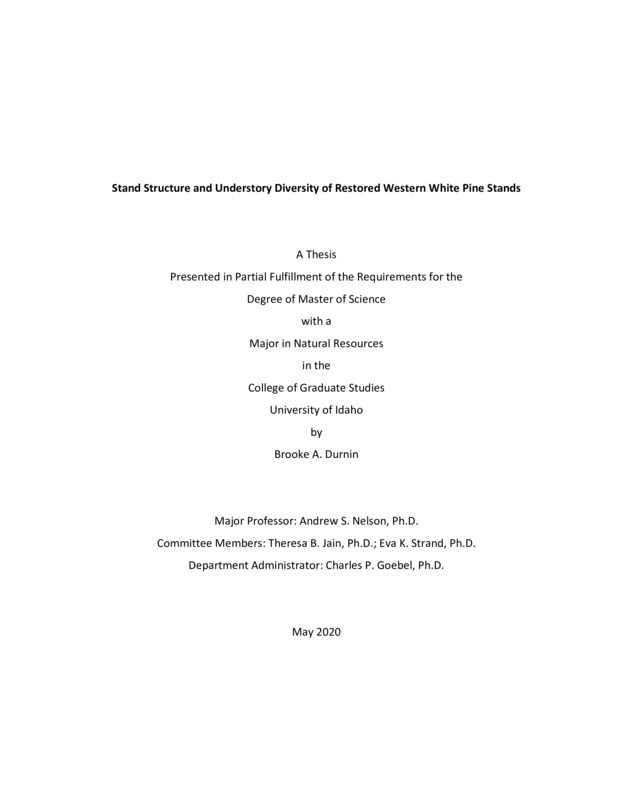Stand Structure and Understory Diversity of Restored Western White Pine Stands
Durnin, Brooke Ann. (2020-05). Stand Structure and Understory Diversity of Restored Western White Pine Stands. Theses and Dissertations Collection, University of Idaho Library Digital Collections. https://www.lib.uidaho.edu/digital/etd/items/durnin_idaho_0089n_11757.html
- Title:
- Stand Structure and Understory Diversity of Restored Western White Pine Stands
- Author:
- Durnin, Brooke Ann
- ORCID:
- 0000-0002-4376-9675
- Date:
- 2020-05
- Program:
- Natural Resources
- Subject Category:
- Forestry
- Abstract:
-
Western white pine (Pinus monticola Dougl. ex. D. Don) once dominated the northern Rocky Mountains of the US and Canada. These forests were multi strata stands with white pine dominating in the overstory and more shade tolerant species occupying lower strata. In the early 1900s white pine blister rust (Cronartium ribicola) was introduced, which caused a major shift in forest management. White pine along with other shade intolerant species were preferentially harvested resulting in a forested landscape dominated by more shade tolerant tree species. These shade tolerant species are more susceptible to biotic and abiotic disturbances and have a less ecologic and economic value. Planting of blister rust-resistant white pine seedlings only became more frequent in the last 30 to 40 years, yet there has been little evaluation of ecology of these planted white pine stands. Therefore, the first objective of this thesis is to describe the structure, tree species composition, and tree growth of western white pine plantations. The second objective of this thesis was to examine the understory floristic diversity of planted white pine stands in relation to canopy characteristics and overstory species composition across the Northern Rockies. Twenty-seven stands planted on federal and private timberlands prior to 1991, were selected across northern Idaho. The majority of these stands were planted solely with western white pine, but similar aged, naturally regenerated stands with fewer western white pine were also selected. Results show these stands as containing an even-aged stratified mixture with an abundance of shade tolerant seedlings and saplings. We also found the total merchantable volume increased with an increasing amount of white pine in the stand. These planted stands also have a very diverse understory with species composition similar to that of historic stands, documented in previous literature. Results from this study will be used by forest managers to assess the effects of western white pine composition on stand structure, vegetation community diversity and will help direct future management efforts to reintroduce this iconic species into the forests of the region.
- Description:
- masters, M.S., Natural Resources -- University of Idaho - College of Graduate Studies, 2020-05
- Major Professor:
- Nelson, Andrew S
- Committee:
- Jain, Theresa B; Strand, Eva K
- Defense Date:
- 2020-05
- Identifier:
- Durnin_idaho_0089N_11757
- Type:
- Text
- Format Original:
- Format:
- application/pdf
- Rights:
- In Copyright - Educational Use Permitted. For more information, please contact University of Idaho Library Special Collections and Archives Department at libspec@uidaho.edu.
- Standardized Rights:
- http://rightsstatements.org/vocab/InC-EDU/1.0/

